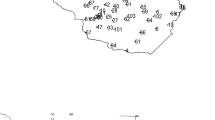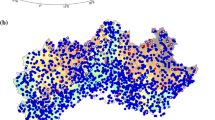Abstract
Amount and time distributions, X and Y, of daily rain amounts in Europe along the second half of 20th century have been studied from 267 rain gauge records. Different geographical features, such as latitude, vicinity to Mediterranean Sea or the Atlantic Ocean or altitude above sea level, cause the averages of daily rain and annual number of rainy days to vary within a wide range. The largest daily percentiles of amount and time distributions are reached at latitudes south of 50°N and in southwestern Norway. The amount of distribution, X, is well-modelled by the exponential function, with parameters derived from probability graphs. Time distributions, Y, are well-fitted by Pearson type III (Gamma) and Weibull models, their parameters being estimated by L-moments. Normalised rainfall curves (NRC) have been modelled by the analytical function \( X = Y \cdot \exp \left\{ { - b{{\left( {1 - Y} \right)}^c}} \right\} \), with b and c parameters depicting spatial variability. Alternatively, the beta distribution also describes quite well the empirical NRCs, with parameters estimated by statistical moments. The coordinates of the average daily amount (X r , Y r ) and the values of X* and Y*, which are defined as the fraction of rain amount for a half of rainy days and the fraction of number of rainy days accounting for a half of total rain amount, respectively, depict very similar spatial distribution throughout Europe. In fact, X r and X* keep a linear relationship, as well as Y r and Y*, the four coordinates depending on the coefficient of variation of daily rain amounts. A similar linear relationship is found for the pair (X*, Y*). Finally, the Average Linkage algorithm applied to the coordinates X r , Y r , X* and Y* characterising every one of the 267 NRCs permits to group the rain gauges into several spatial clusters, each of them related to a different normalised daily pluviometric regime.
















Similar content being viewed by others
References
Ahrens CD (1994) Meteorology today. West Publishing Company, St. Paul/Minneapolis, p 592
Alijani B, O’Brien J, Yarnal B (2008) Spatial analysis of precipitation intensity and concentration in Iran. Theor Appl Climatol 94:107–124
Allan RP, Soden BJ (2008) Atmospheric warming and the amplification of precipitation extremes. Science 321:1481–1484
Ananthakrishnan R, Rajan CK (1987) Some features of the south-west monsoon rainfall of Cochin and Minicoy. J Climatol 7:355–372
Ananthakrishnan R, Soman MK (1989) Statistical distribution of daily rainfall and its association with the coefficients of variation of rainfall series. Int J Climatol 9:485–500
Benjamin JR, Cornell A (1970) Probability, statistics and decision for civil engineering. McGraw-Hill, New York
Burgueño A, Serra C, Lana X (2004) Monthly and annual statistical distributions of the daily rainfall at the Fabra Observatory (Barcelona, NE Spain) for the years 1917–1999. Theor Appl Climatol 77:57–75
Burgueño A, Martínez MD, Lana X, Serra C (2005) Statistical distributions of the daily rainfall regime in Catalonia (northeastern Spain) for the years 1950–2000. Int J Climatol 25:1381–1403
Dai A (2001) Global precipitation and thunderstorm frequencies. Part I: seasonal and interannual variations. J Climate 14:1092–1111
Groisman PY, Karl TR, Easterling DR, Knight RW, Jamason PF, Hennessy KJ, Suppiah R, Page CM, Wibig J, Fortuniak K, Razuvaev VN, Douglas A, Fǿrland E, Zhai PM (1999) Changes in the probability of heavy precipitation: important indicators of climate change. Clim Change 42:243–283
Groisman PY, Knight RW, Easterling DR, Karl TR, Hegerl GC, Razuvaev VN (2005) Trends in intense precipitation in the climate record. J Climate 18:1326–1350
Guilló AM, Puigcerver M (1970) Sobre las contribuciones relativas de las precipitaciones local y generalizada a la precipitación total en Cataluña. Rev Geofís 29:205–216
Harrison MSJ (1983) Rain day frequency and mean daily rainfall intensity as determinants of total rainfall over the eastern Orange Free State. J Climatol 3:35–45
Haylock MR, Hofstra N, Klein Tank AMG, Klok EJ, Jones PD, New M (2008) A European daily high-resolution gridded data set of surface temperature and precipitation for 1950-2006. J Geophys Res 113:D20119. doi:10.1029/2008JD010201
Hegerl GC, Zwiers FW, Stott PA, Kharin VV (2004) Detectability of anthropogenic changes in annual temperature and precipitation extremes. J Climate 17:3683–3700
Hofstra N, Haylock M, New M, Jones P, Frei C (2008) Comparison of six methods for the interpolation of daily, European climate data. J Geophys Res 113:D21110. doi:10.1029/2008JD010100
Hosking JRM, Wallis JR (1997) Regional frequency analysis. Cambridge University Press, Cambridge, p 224
Jolliffe IT, Hope PB (1996) Representation of daily rainfall distributions using normalised rainfall curves. Int J Climatol 16:1157–1163
Kalkstein LS, Tan G, Skinlov JA (1987) An evaluation of three clustering procedures for use in synoptic climatological classifications. J Clim Appl Meteorol 26:717–730
Klein Tank AMG, Wijngaard JB, Können GP, Böhm R, Demarée G, Gocheva A, Mileta M, Pashiardis S, Hejkrlik L, Kern-Hansen C, Heino R, Bessemoulin P, Müller-Wetermeier G, Tzanakou M, Szalai S, Pálsdóttir T, Fitzgerald D, Rubin S, Capaldo M, Maugeri M, Leitass A, Bukantis A, Aberfeld R, Van Engelen AFV, Fǿrland E, Mietus M, Coelho F, Mares C, Razuvaev V, Nieplova E, Cegnar T, López JA, Dahlström B, Moberg A, Kirchhofer W, Ceylan A, Pachaliuk O, Alexander LV, Petrovic P (2002) Daily dataset of 20th-century air temperature and precipitation series for the European climate assessment. Int J Climatol 22:1441–1453
Klok EJ, Klein Tank AMG (2009) Updated and extended European dataset of daily climate observations. Int J Climatol 29:1182–1191
Kundzewicz ZW, Radziejewski M, Pińskwar I (2006) Precipitation extremes in the changing climate of Europe. Clim Res 31:51–58
Lana X, Burgueño A (1998) Spatial and temporal characteristics of annual extreme droughts in Catalonia (NE Spain). Int J Climatol 18:93–110
Lana X, Martínez MD, Burgueño A, Serra C, Martín-Vide J, Gómez L (2008) Spatial and temporal patterns of dry spell lengths in the Iberian Peninsula for the second half of the twentieth century. Theor Appl Climatol 91:99–116
Legates DR (1995) Global and terrestrial precipitation: a comparative assessment of existing climatologies. Int J Climatol 15:237–258
Legates DR, Willmott CJ (1990) Mean seasonal and spatial variability in gauge-corrected, global precipitation. Int J Climatol 10:111–127
Martin LA (1964) An investigation of the rainfall distribution for stations in north and Central America”, in Research on Tropical Rainfall Patterns and Associated Meso-scale Systems. Department of Meteorology, Texas A & M University, 1-55
Martín-Vide J (2004) Spatial distribution of a daily precipitation concentration index in Peninsular Spain. Int J Climatol 24:959–971
Olascoaga MJ (1950) Some aspects of Argentina rainfall. Tellus 2:312–318
Petty GW (1995) Frequencies and characteristics of global oceanic precipitation from shipboard present-weather reports. Bull Amer Meteorol Soc 76:1593–1616
Rai Sircar NC (1955) Some aspects of monsoon rainfall in India. J Meteorol Geophys 6:217–224
Räisänen J, Hansson U, Ullerstig A, Döscher R, Graham LP, Jones C, Meier HEM, Samuelsson P, Willén U (2004) European climate in the late twenty-first century: regional simulations with two driving global models and two forcing scenarios. Clim Dyn 22:13–31
Riehl H (1979) Climate and weather in the tropics. Academic Press, London, pp 106–114
Soman MK, Krishna Kumar K (1990) Some aspects of daily rainfall distribution over India during the south-west monsoon season. Int J Climatol 10:299–311
Sun Y, Solomon S, Dai A, Portmann RW (2006) How often does it rain? J Climate 19:916–934
Trenberth KE, Dai A, Rasmussen RM, Parsons DB (2003) The changing character of precipitation. Bull Amer Meteorol Soc, 1205–1217
Wentz FJ, Ricciardulli L, Hilburn K, Mears C (2007) How much more rain will global warming bring. Science 317:233–235
Wexler RL (1967) Annual versus daily rainfall: southeast Asia. In: Proceedings of technical exchange conference, 4-7 April 1967, AWS Technical Report 196, 226-242
Wijngaard JB, Klein Tank AMG, Können GP (2003) Homogeneity of 20th century European daily temperature and precipitation series. Int J Climatol 23:679–692
Xie P, Arkin PA (1997) Global precipitation: a 17-year monthly analysis based on gauge observations, satellite estimates, and numerical model outputs. Bull Amer Meteor Soc 78:2539–2558
Zhang X, Zwiers FW, Hegerl GC, Lambert FH, Gillett NP, Solomon S, Stott PA, Nozawa T (2007) Detection of human influences on twentieth-century precipitation trends. Nature 448:461–465
Zolina O, Kapala A, Simmer C, Gulev SK (2004) Analysis of extreme precipitation over Europe from different reanalyses: a comparative assessment. Global Planet Change 44:129–161
Author information
Authors and Affiliations
Corresponding author
Appendix
Appendix
Theoretical distributions applied to the different random variables studied (Benjamin and Cornell 1970; Hosking and Wallis 1997).
-
(a)
Exponential distribution
-
(b)
Pearson type III (Gamma) distribution
where
And Γ(·) denotes the gamma function
-
(c)
Weibull distribution
-
(d)
Beta type I distribution
where Γ(·) again denotes the gamma function
Rights and permissions
About this article
Cite this article
Burgueño, A., Martínez, M.D., Serra, C. et al. Statistical distributions of daily rainfall regime in Europe for the period 1951–2000. Theor Appl Climatol 102, 213–226 (2010). https://doi.org/10.1007/s00704-010-0251-5
Received:
Accepted:
Published:
Issue Date:
DOI: https://doi.org/10.1007/s00704-010-0251-5




